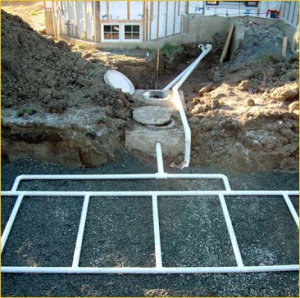One third of homes in Florida rely on septic systems, or onsite sewage treatment and disposal systems (OSTDS), to treat and dispose of household wastewater, which includes wastewater from bathrooms, kitchen sinks and laundry machines. When properly maintained, septic systems can last 25-30 years, and maintenance costs are relatively low.
A general rule of thumb is that with proper care, systems need to be pumped every 3-5 years at a cost of about $300 to $400. Time between pumping does vary though, depending on the size of your household, the size of your septic tank and how much wastewater you produce. If systems aren’t maintained they can fail, and repairs or replacing a tank can cost anywhere between $3000 to $10,000. It definitely pays off to maintain your septic system!
The most common type of OSTDS is a conventional septic system, which is made up of a septic tank (a watertight container buried in the ground) and a drain field, or leach field. The septic tank’s job is to separate out solids (which settle on the bottom as sludge), from oils and grease, which float to the top and form a scum layer. The liquid wastewater, which is in the middle layer of the tank, flows out through pipes into the drainfield, where it percolates down through the ground.
Although bacteria continually work on breaking down the organic matter in your septic tank, sludge and scum will build up, which is why a system needs to be cleaned out periodically. If not, solids will flow into the drainfield clogging the pipes and sewage can back up into your house. Overloading the system with water also reduces its ability to work properly by not leaving enough time for material to separate out in the tank, and by flooding the system. Sewage can flow to the surface of your lawn and/or back up into your house.
Failed septic systems not only result in soggy lawns and horrible smells, but they contaminate groundwater, private and public supply wells, creeks, rivers and many of our estuaries and coastal areas with excess nutrients, like nitrogen, and harmful pathogens, like E. coli.
It is important to note that even when traditional septic systems are maintained, they are still a source of nitrogen to groundwater; nitrate is not fully removed from the wastewater effluent.
How can you properly care for your septic system?
Here are a some basic tips to keep your system working properly so that you can reduce maintenance costs by avoiding system failure, and so that you can reduce your household’s impact on water pollution in your area.
- Don’t flush trash down the toilet. Only flush regular toilet paper. Toilet paper treated with lotion forms a layer of scum. Wet wipes are not flushable, although many brands are labelled as such. They wreak havoc on septic systems! Avoid flushing cigarette butts, paper towels and facial tissues, which can take longer to break down than toilet paper.
- Think at the sink. Avoid pouring oil and fat down the kitchen drain. Avoid excessive use of harsh cleaning products and detergents, which can affect the microbes in your septic tank (regular weekly or so cleaning is fine). Prescription drugs and antibiotics should never be flushed down the toilet.
- Limit your use of the garbage disposal. Disposals add organic matter to your septic system, which results in the need for more frequent pumping. Composting is a great way to dispose of your fruit and vegetable scraps instead.
- Take care at the surface of yourtank and drainfield. To work well, a septic system should be surrounded by non-compacted soil. Don’t drive vehicles or heavy equipment over the system. Avoid planting trees or shrubs with deep roots that could disrupt the system or plug pipes. It is a good idea to grow grass over the drainfield to stabilize soil and absorb liquid and nutrients.
- Conserve water. You can reduce the amount of water pumped into your septic tank by reducing the amount you and your family use. Water conservation practices include repairing leaky faucets, toilets and pipes, installing low cost, low-flow showerheads and faucet aerators, and only running the washing machine and dishwasher when full. In the US, most of the household water used is to flush toilets (about 27%). Placing filled water bottles in the toilet tank is an inexpensive way to reduce the amount of water used per flush.
- Have your septic system pumped by a certified professional. The general rule of thumb is every 3-5 years, but it will depend on household size, the size of your septic tank and how much wastewater you produce.
By following these guidelines, you can contribute to the health of your family, community and environment, as well as avoid costly repairs and septic system replacements.
You can find excellent information on septic systems a the US EPA website: https://www.epa.gov/septic. The Florida Department of Health website provides permiting information for Florida and a list of certified maintenance entities by county: http://www.floridahealth.gov/Environmental-Health/onsite-sewage/index.html.

The Department of Environmental Protection (FDEP) identified septic systems as the major source of nitrate in Wakulla Springs, located in Wakulla County. Excess nitrate is thought to promote algal growth, leading to the degradation of the biological community in the spring.
Photo: Andrea Albertin
- What to Do if a Sinkhole Opens on Your Property? - June 6, 2025
- Workshop on Private Well and Septic System Basics - October 18, 2024
- Septic system maintenance after a flood - June 7, 2024

